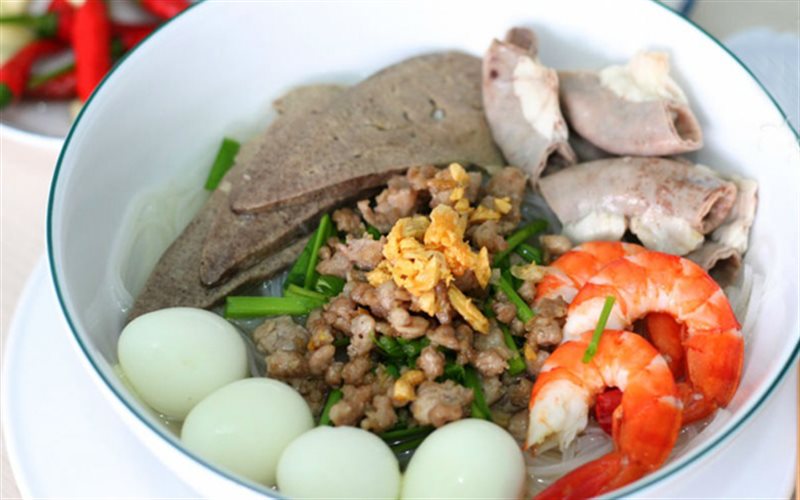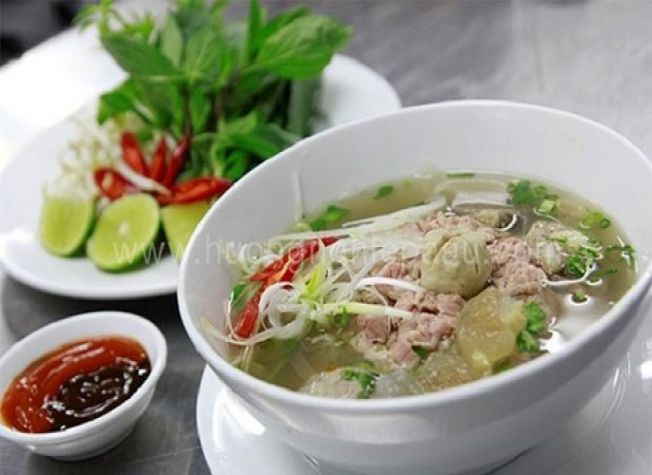Hủ Tiếu Saigon: Vietnam Noodle Soup Recipe, Ingredients
Hủ Tiếu, also written as Hủ Tíu (in the Southern Vietnamese dialect: Tiếu is the same pronunciation as Tíu), is a dish using rice noodle of the Chaozhou and Min Nam people, with many similarities to saha chalk of the Cantonese people and the cashew version of the Hakka people, was introduced to many regions inside and outside China, becoming a common dish in the South China region and Southeast Asia as in Southern Vietnam. South, Cambodia, Laos, Thailand, Singapore, etc.
1. Origin of Hủ Tiếu Noodle Soup in Saigon:
Hủ Tiếu Noodle Soup originated from the Teochew (or Chaozhou) language, also written as hu tiu in some Vietnamese regional dialects. Although it is commonly thought that hu tiu was created by Khmer and Cambodian people, this noodle soup was actually introduced by Chinese people living in Phnom Penh, Cambodia. The original noodles used in Chinese cuisine, called “hu tieu mem,” resemble Vietnamese Pho Noodles: they are soft, flat, slippery, and slightly chewy.

Hủ Tiếu Noodle Soup
However, people in the South of Vietnam did not appreciate this type of noodle because it gave the dish a similar quality to Pho, thereby reducing the unique essence of hu tieu. To address this, they utilized the abundance of rice in the Mekong Delta and created their own version of noodles, known as “hu tieu dai” (chewy noodles), which are chewier, more transparent, and made from rice starch. These noodles are also smaller in size compared to pho or Chinese soft noodles.

Dry Hủ Tiếu Noodle
By adapting cooking methods, ingredients, and making adjustments to local tastes and available produce, the Vietnamese created their own version of Hủ Tiếu, which deeply reflects their culinary culture.
2. Some Types of Hủ Tiếu Noodle in Southern Vietnam:
Hu Tieu has been around for over a hundred of years and became widely popular in the 1950s, particularly in Saigon/Ho Chi Minh City. During that time, it was sold from food carts decorated with Chinese paintings and writings. Over time, the taste and ingredients were adjusted to suit local palates, resulting in the creation of exceptional versions of hu tieu, of which Nam Vang, My Tho, and Sa Dec are the most well-known.

Hủ Tiếu Noodle Soup
Regardless of the different variations, all hu tieu recipes share a flavorful broth with a thin layer of oil on top. Underneath is a clear, light soup that has been slow-cooked for 7-8 hours, resulting in a sweet taste derived from pork bones and white carrots. Three key ingredients, grilled red onions, dried squid, and shrimp, add a smoky depth to the broth while also imparting a mild sea scent. What truly sets the three famous varieties of hu tieu apart is their toppings and garnishes, which we will delve into in more detail.
3. Recipe of How to Make Hủ Tiếu Noodle Soup:
3.1. Preparing Ingredients:
- Clean the tubules. Put the bones in a pot of boiling water, then take them out and rinse with cold water.
- Boiled quail eggs, peeled off the shell.
- Shrimp peeled, split back and washed with salt.
- Boiled liver and cut into thin slices. Tenderloin washed, boiled, thinly sliced.
- Wash celery, cut into small pieces. Price live washed.
- Wash the scallions, cut the onion head into long pieces, and cut the onion leaves into small pieces. Chives cut into long pieces.
- White radish, peeled, washed and cut into circles.
3.2. How to Cook Hủ Tiếu Noodle Soup:
- Put the ground meat in the hot oil pan, stir-fry until the meat is firm, add a little MSG and fish sauce, stir well and then put in a bowl.
- Pour the noodles into the broth, put the noodles in a bowl.
- Put the bones that have been lightly burned into the stew pot, let the fire simmer slowly until the bones are soft. Continue to cook the white radish, when the bones and tubers are soft, season with the seasoning and then turn off the stove. During the cooking process, often skim off the foam to make the broth clearer.
3.3. Finished product
- Put the noodles in a bowl, put the tenderloin, shrimp, liver, quail eggs and fried minced meat on top. Add chopped shallots, onions, and celery and pour the noodle soup over.
4. How to Eat Vietnamese Hủ Tíu Noodle Soup?
Hủ Tíu Noodle Soup is typically eaten for breakfast or dinner, as lunchtime can often be too hot to enjoy a steaming bowl of noodle soup. The dish is served in two ways: Nuoc (Soup with Broth) or Khô (with Sauce). Hu tieu nuoc, meaning watery hu tieu, is served in one bowl with the noodles, toppings, and broth mixed together. On the other hand, hu tieu kho, or dry hu tieu, is served in two separate bowls, with the noodles and toppings in one and the soup in another. This option is preferred by some because it allows the noodles to stay chewy and the broth to maintain its sweetness by not being mixed with the rice powder that can be released from the noodles. The noodles are coated in a special sauce made from broth, soy sauce, hoisin sauce, and kitchen seasonings, giving them a caramel color and savory taste.
If you are not a fan of pork organs, don’t worry! Simply tell the staff to remove them by saying “khong do long,” meaning “no pork organs,” or by pointing to them at the food counter and signaling “no.”
For the green garnish, you have two options: rau song (fresh vegetables) or rau trung (blanched vegetables). If you are not used to the intense flavor of Vietnamese greens, it is recommended to choose the blanched option.
When you visit a hu tieu restaurant, you will likely see a tray of seasoning garnishes on the table, including soy sauce, fresh sliced chilies, sauteed chili, cut lemons, and pickles. Squeezing some lemon into the soup is a common practice to balance the sweetness.
At the restaurant, you may be provided with wet wipes, but these are usually not free and can cost around 2,000 VND ($0.1) each. Similarly, iced tea may also be offered. If it is brought to your table immediately after you sit down, it is often free; otherwise, it may cost the same as the wet wipes. We suggest ordering a glass of iced tea or sugarcane juice to enjoy with your hot bowl of hu tieu, as the combination of a steaming soup and a refreshing drink is perfect.
5. Where are the Best Places to Try Authentic Hủ Tiếu?
The reputation and popularity of Hủ Tiếu Noodle Soup in the South are equivalent to pho in the North. It absolutely deserves more recognition among international travelers and food lovers. We hope this introduction gives you a new perspective on Vietnamese Cuisine. It is not only about Pho and Banh Mi but a whole lot of regional noodle soup varieties. Now that you have more food options on your list, let’s plan your next trip to Vietnam and try them out. Here are some suggestions on best local restaurants to try authentic Hủ Tiếu in Vietnam:
5.1. Best Places to Try Hủ Tiếu in District 1, Saigon/Ho Chi Minh:
Hu Tieu Nam Vang Thanh Dat:
- Address: 34 Co Bac, District 1, Ho Chi Minh City
- Price: 59,000 VND – 69,000 VND ($2.5 – $3)
Hu Tieu Nhan Quan:
- Address: A68 Nguyen Trai, District 1, Ho Chi Minh City
- Price: 85,000 VND – 120,000 VND
Hu Tieu My Tho Thanh Xuan:
- Address: 62 Ton That Thiep, District 1, Ho Chi Minh City
- Price: 32,000 VND – 60,000 VND
5.2. Best Places to Try Hủ Tiếu in My Tho City, Mekong Delta
Hu Tieu My Tho 43:
- Address: 305 Ap Bac, Ward 10, My Tho City
- Price: 50,000 VND
Hu Tieu Tuyet Ngan:
- Address: 481 Ap Bac, Ward 5, My Tho City
- Price: 40,000 VND – 60,000 VND
5.3. Best Places to Try Hủ Tiếu in Sa Dec City of Mekong Delta
Hu Tieu Ba Sam:
- Address: 188 Tran Hung Dao, Ward 1, Sa Dec City
- Price: 10,000 VND
Hu Tieu Chi Dau:
- Address: 292 Tran Hung Dao, Ward 1, Sa Dec City
- Price: 20,000 VND
See Also:

![]()
![]()
![]()
![]()
![]()
Best of Vietnam

Best Vietnamese Food You Have to Try in Vietnam
Best Food in Vietnam: Vietnamese Traditional Food is top World well known to be both healthy and...

10 Best National Parks in Vietnam
Vietnam Travel Guide: If you look for the Best Wildlife Discovery Experience in Vietnam, here are...
Read More
Best Souvenir to Buy in Vietnam
If you look for Best Things to Buy when traveling to Vietnam to bring home for your family & friends...
Read More
The 10 Best Places to Visit in Vietnam
Vietnam Travel Guide: Home to an extensive collection of historical and cultural attractions,...
Read More
Top 10 Museums You Should Not Miss in Vietnam
Vietnam, 4.000 years old country has a unique and lengthy history, culture with 54 ethnic groups. It...
Read MoreFind your trip
Vietnam Best Tours
Vietnam Car Rental
Vietnam Travel Blog
- Vietnamese People: Origin, History, Culture and Traditions
- Vietnam Currency: Best ATM and Places to Exchange Money
- Vietnam Map: Regions, Cities & Provinces Map of Vietnam
- What is illegal Things in Vietnam: Rules & Laws for Tourists
- Best Time to Travel to Vietnam to Avoid the Bad Weather
- Vietnam News: Population & Religions of 54 Ethnic Groups









